Case Study: Workflow Analysis and Management at Honeywell University
VerifiedAdded on 2023/06/06
|18
|5891
|205
Case Study
AI Summary
This case study analyzes the workflow management at Honeywell, focusing on the company's strategic approach to world-class manufacturing (WCM). It examines Honeywell's organizational vision, leadership, and the implementation of WCM to improve processes and reduce defects. The analysis covers process mapping, defect diagnosis, fail-safing techniques, teamwork, and the role of information technology. The study highlights the enablers and barriers to execution, the process of change management, and lessons learned, including the importance of social innovation. The case study demonstrates how Honeywell used business process re-engineering to differentiate itself and achieve significant improvements in efficiency, customer satisfaction, and cost reduction. The study also provides a detailed breakdown of the 'TotalPlantTM' paradigm and its four key aspects: process mapping, fail-safing, teamwork, and communication, which are crucial in enhancing the efficiency of the business activities. Finally, the study presents the implementation plan which includes consultation, confirmation and implementation.
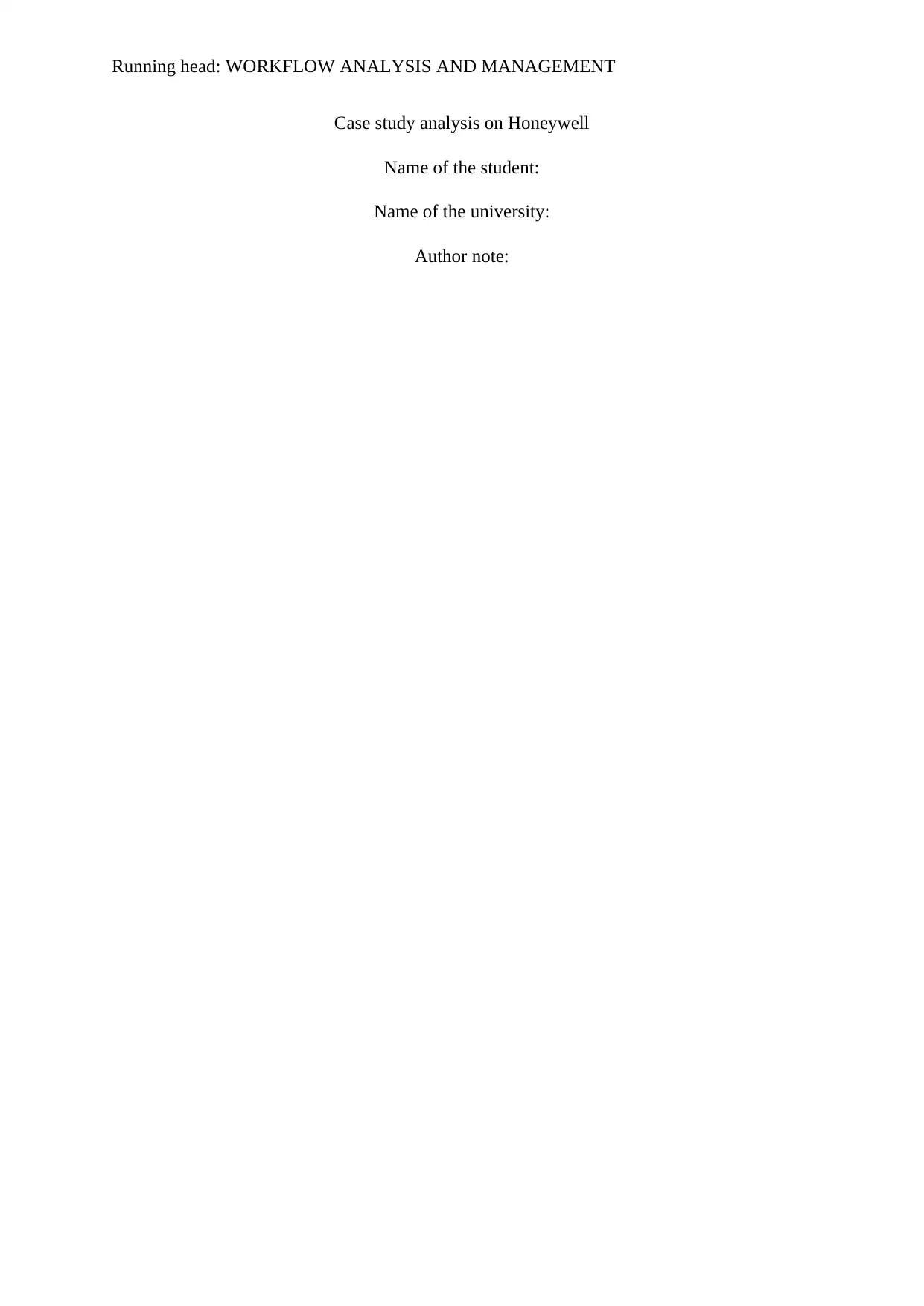
Running head: WORKFLOW ANALYSIS AND MANAGEMENT
Case study analysis on Honeywell
Name of the student:
Name of the university:
Author note:
Case study analysis on Honeywell
Name of the student:
Name of the university:
Author note:
Paraphrase This Document
Need a fresh take? Get an instant paraphrase of this document with our AI Paraphraser
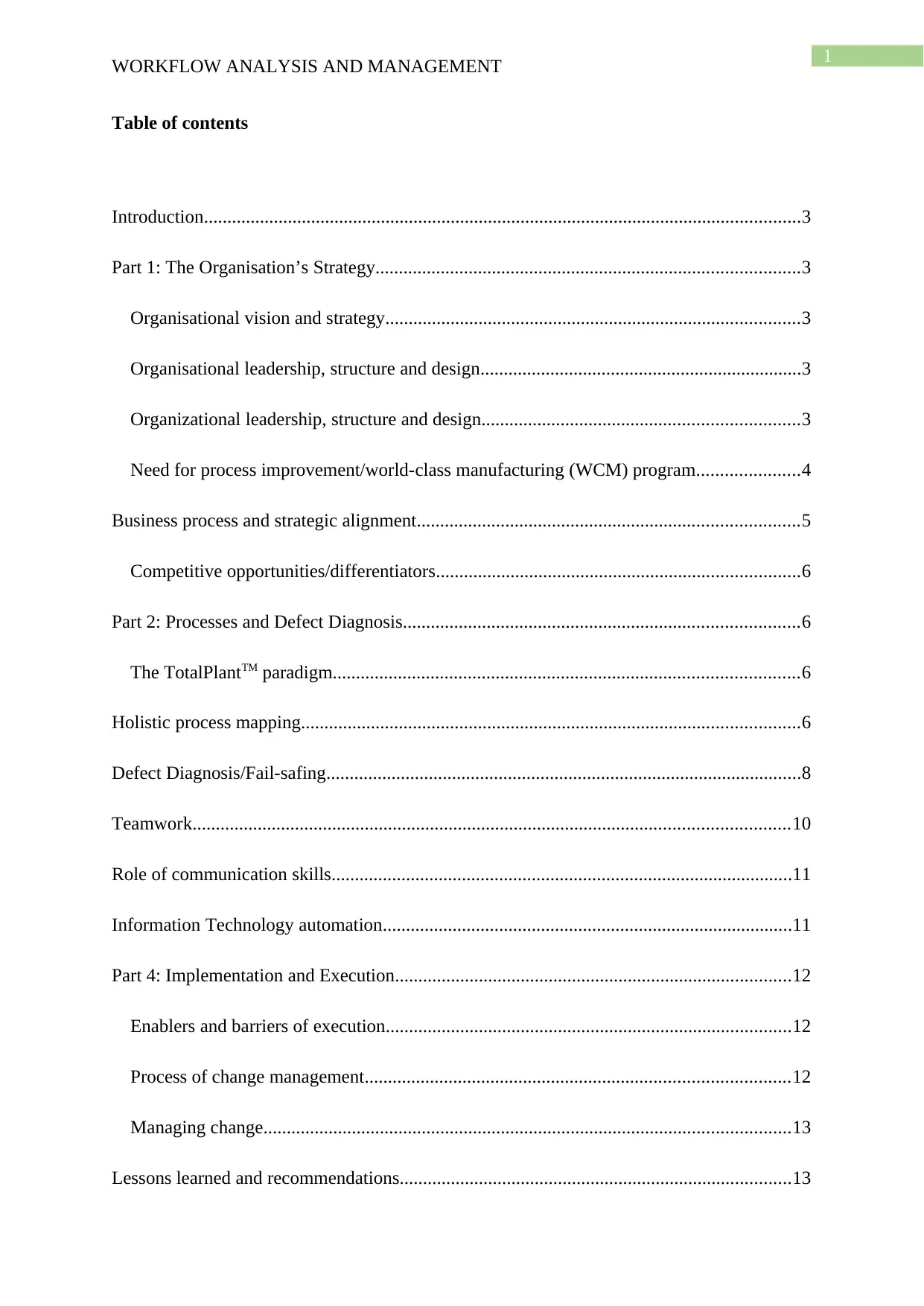
1
WORKFLOW ANALYSIS AND MANAGEMENT
Table of contents
Introduction................................................................................................................................3
Part 1: The Organisation’s Strategy...........................................................................................3
Organisational vision and strategy.........................................................................................3
Organisational leadership, structure and design.....................................................................3
Organizational leadership, structure and design....................................................................3
Need for process improvement/world-class manufacturing (WCM) program......................4
Business process and strategic alignment..................................................................................5
Competitive opportunities/differentiators..............................................................................6
Part 2: Processes and Defect Diagnosis.....................................................................................6
The TotalPlantTM paradigm....................................................................................................6
Holistic process mapping...........................................................................................................6
Defect Diagnosis/Fail-safing......................................................................................................8
Teamwork................................................................................................................................10
Role of communication skills...................................................................................................11
Information Technology automation........................................................................................11
Part 4: Implementation and Execution.....................................................................................12
Enablers and barriers of execution.......................................................................................12
Process of change management...........................................................................................12
Managing change.................................................................................................................13
Lessons learned and recommendations....................................................................................13
WORKFLOW ANALYSIS AND MANAGEMENT
Table of contents
Introduction................................................................................................................................3
Part 1: The Organisation’s Strategy...........................................................................................3
Organisational vision and strategy.........................................................................................3
Organisational leadership, structure and design.....................................................................3
Organizational leadership, structure and design....................................................................3
Need for process improvement/world-class manufacturing (WCM) program......................4
Business process and strategic alignment..................................................................................5
Competitive opportunities/differentiators..............................................................................6
Part 2: Processes and Defect Diagnosis.....................................................................................6
The TotalPlantTM paradigm....................................................................................................6
Holistic process mapping...........................................................................................................6
Defect Diagnosis/Fail-safing......................................................................................................8
Teamwork................................................................................................................................10
Role of communication skills...................................................................................................11
Information Technology automation........................................................................................11
Part 4: Implementation and Execution.....................................................................................12
Enablers and barriers of execution.......................................................................................12
Process of change management...........................................................................................12
Managing change.................................................................................................................13
Lessons learned and recommendations....................................................................................13
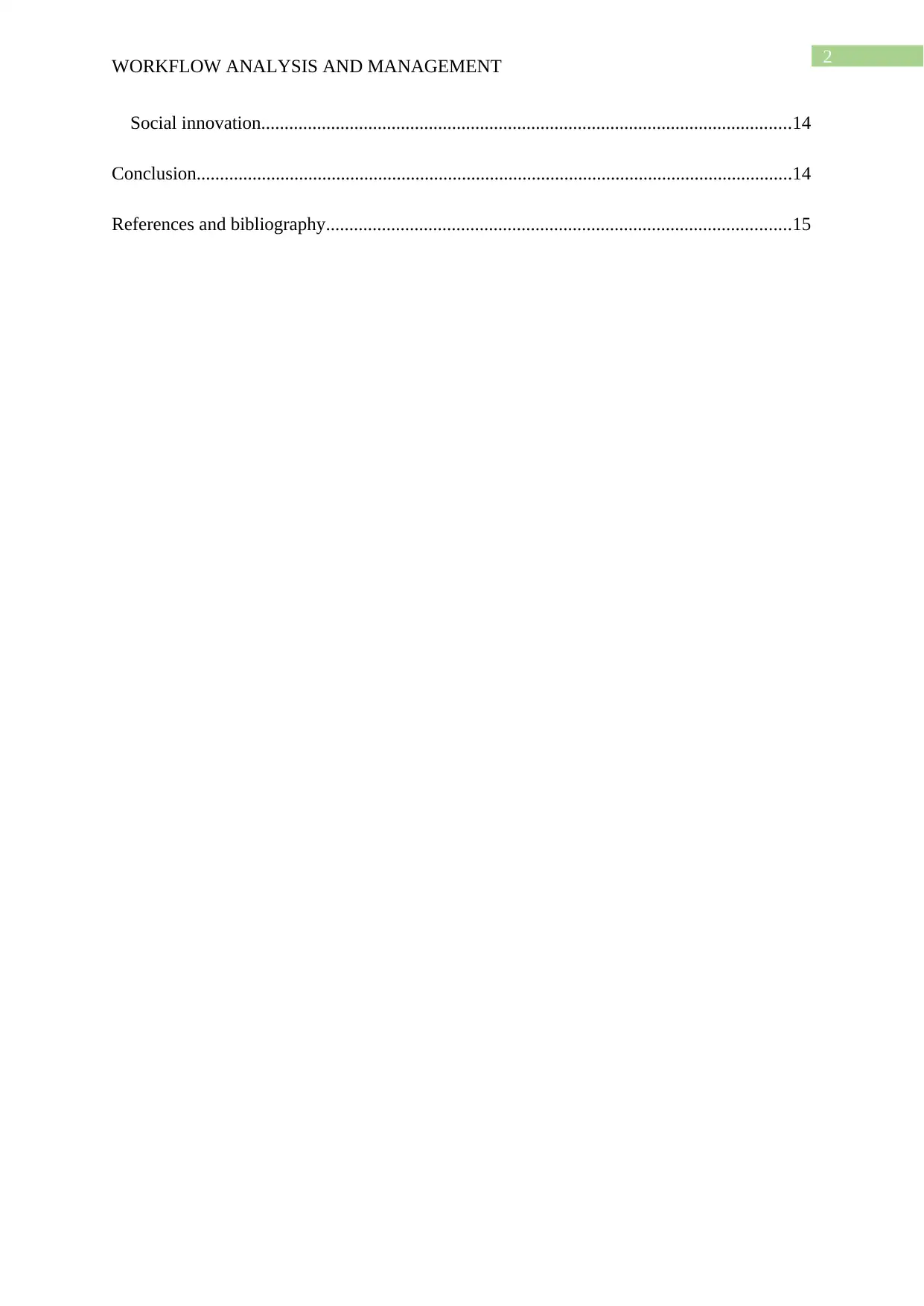
2
WORKFLOW ANALYSIS AND MANAGEMENT
Social innovation..................................................................................................................14
Conclusion................................................................................................................................14
References and bibliography....................................................................................................15
WORKFLOW ANALYSIS AND MANAGEMENT
Social innovation..................................................................................................................14
Conclusion................................................................................................................................14
References and bibliography....................................................................................................15
⊘ This is a preview!⊘
Do you want full access?
Subscribe today to unlock all pages.

Trusted by 1+ million students worldwide
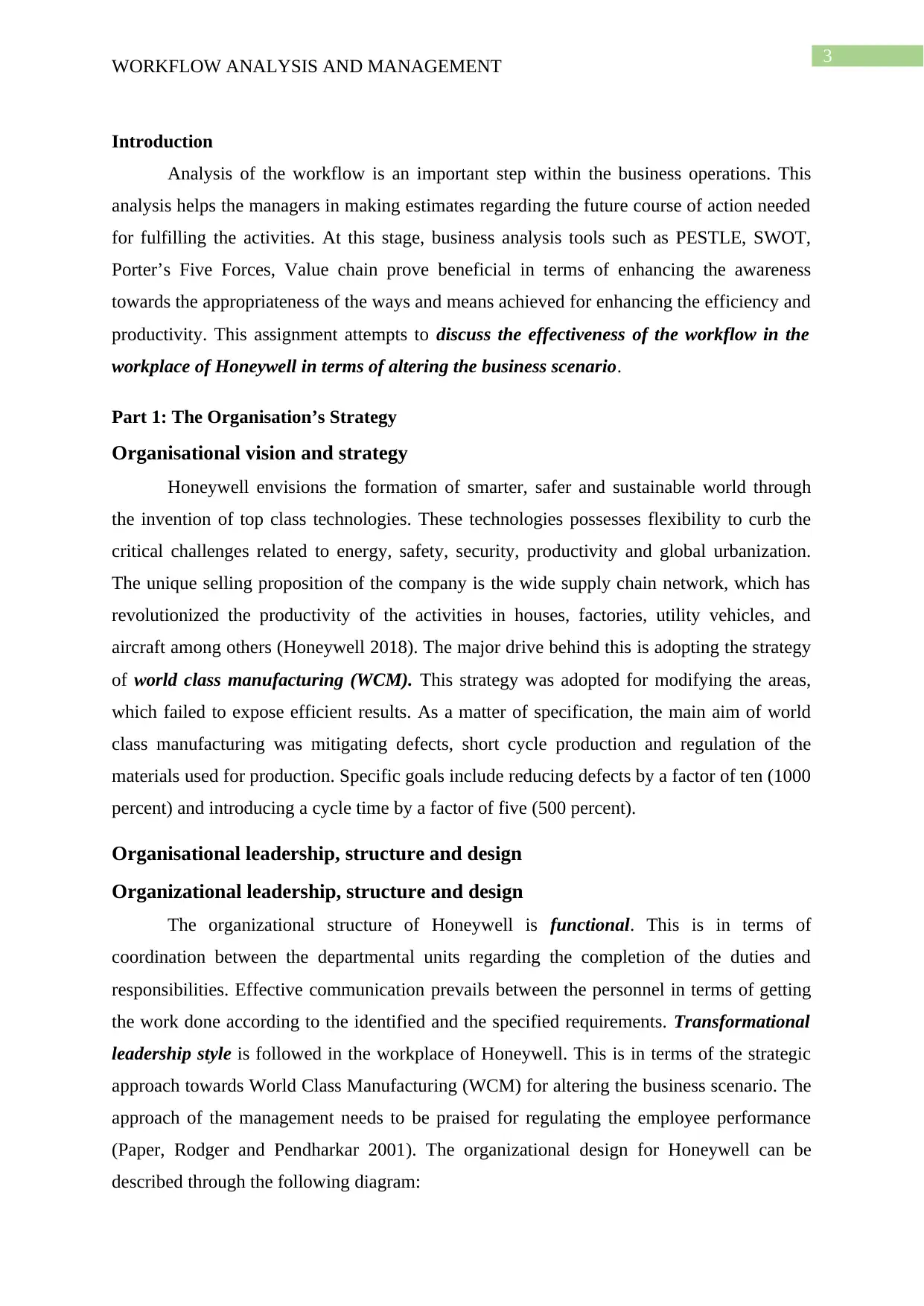
3
WORKFLOW ANALYSIS AND MANAGEMENT
Introduction
Analysis of the workflow is an important step within the business operations. This
analysis helps the managers in making estimates regarding the future course of action needed
for fulfilling the activities. At this stage, business analysis tools such as PESTLE, SWOT,
Porter’s Five Forces, Value chain prove beneficial in terms of enhancing the awareness
towards the appropriateness of the ways and means achieved for enhancing the efficiency and
productivity. This assignment attempts to discuss the effectiveness of the workflow in the
workplace of Honeywell in terms of altering the business scenario.
Part 1: The Organisation’s Strategy
Organisational vision and strategy
Honeywell envisions the formation of smarter, safer and sustainable world through
the invention of top class technologies. These technologies possesses flexibility to curb the
critical challenges related to energy, safety, security, productivity and global urbanization.
The unique selling proposition of the company is the wide supply chain network, which has
revolutionized the productivity of the activities in houses, factories, utility vehicles, and
aircraft among others (Honeywell 2018). The major drive behind this is adopting the strategy
of world class manufacturing (WCM). This strategy was adopted for modifying the areas,
which failed to expose efficient results. As a matter of specification, the main aim of world
class manufacturing was mitigating defects, short cycle production and regulation of the
materials used for production. Specific goals include reducing defects by a factor of ten (1000
percent) and introducing a cycle time by a factor of five (500 percent).
Organisational leadership, structure and design
Organizational leadership, structure and design
The organizational structure of Honeywell is functional. This is in terms of
coordination between the departmental units regarding the completion of the duties and
responsibilities. Effective communication prevails between the personnel in terms of getting
the work done according to the identified and the specified requirements. Transformational
leadership style is followed in the workplace of Honeywell. This is in terms of the strategic
approach towards World Class Manufacturing (WCM) for altering the business scenario. The
approach of the management needs to be praised for regulating the employee performance
(Paper, Rodger and Pendharkar 2001). The organizational design for Honeywell can be
described through the following diagram:
WORKFLOW ANALYSIS AND MANAGEMENT
Introduction
Analysis of the workflow is an important step within the business operations. This
analysis helps the managers in making estimates regarding the future course of action needed
for fulfilling the activities. At this stage, business analysis tools such as PESTLE, SWOT,
Porter’s Five Forces, Value chain prove beneficial in terms of enhancing the awareness
towards the appropriateness of the ways and means achieved for enhancing the efficiency and
productivity. This assignment attempts to discuss the effectiveness of the workflow in the
workplace of Honeywell in terms of altering the business scenario.
Part 1: The Organisation’s Strategy
Organisational vision and strategy
Honeywell envisions the formation of smarter, safer and sustainable world through
the invention of top class technologies. These technologies possesses flexibility to curb the
critical challenges related to energy, safety, security, productivity and global urbanization.
The unique selling proposition of the company is the wide supply chain network, which has
revolutionized the productivity of the activities in houses, factories, utility vehicles, and
aircraft among others (Honeywell 2018). The major drive behind this is adopting the strategy
of world class manufacturing (WCM). This strategy was adopted for modifying the areas,
which failed to expose efficient results. As a matter of specification, the main aim of world
class manufacturing was mitigating defects, short cycle production and regulation of the
materials used for production. Specific goals include reducing defects by a factor of ten (1000
percent) and introducing a cycle time by a factor of five (500 percent).
Organisational leadership, structure and design
Organizational leadership, structure and design
The organizational structure of Honeywell is functional. This is in terms of
coordination between the departmental units regarding the completion of the duties and
responsibilities. Effective communication prevails between the personnel in terms of getting
the work done according to the identified and the specified requirements. Transformational
leadership style is followed in the workplace of Honeywell. This is in terms of the strategic
approach towards World Class Manufacturing (WCM) for altering the business scenario. The
approach of the management needs to be praised for regulating the employee performance
(Paper, Rodger and Pendharkar 2001). The organizational design for Honeywell can be
described through the following diagram:
Paraphrase This Document
Need a fresh take? Get an instant paraphrase of this document with our AI Paraphraser
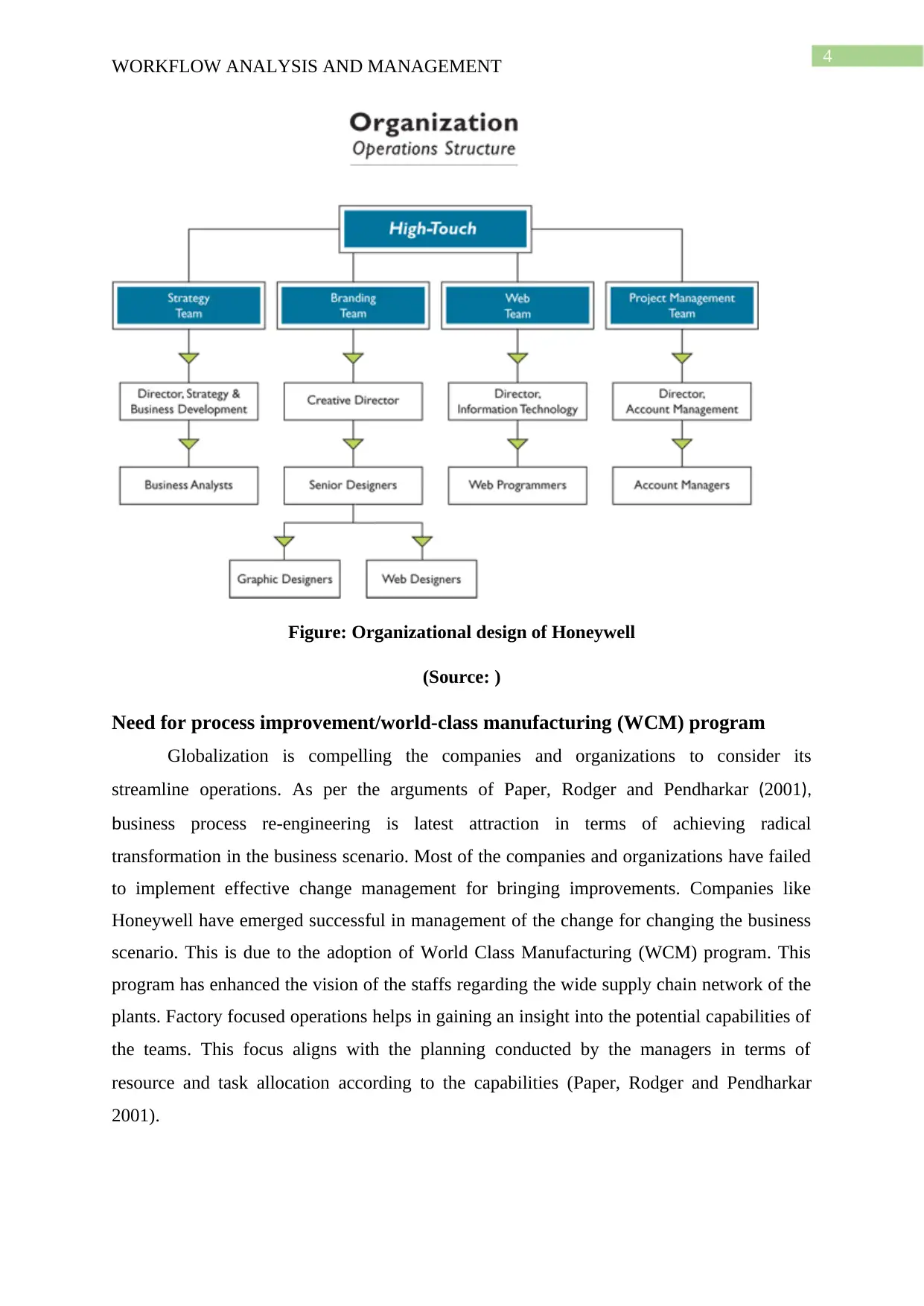
4
WORKFLOW ANALYSIS AND MANAGEMENT
Figure: Organizational design of Honeywell
(Source: )
Need for process improvement/world-class manufacturing (WCM) program
Globalization is compelling the companies and organizations to consider its
streamline operations. As per the arguments of Paper, Rodger and Pendharkar (2001),
business process re-engineering is latest attraction in terms of achieving radical
transformation in the business scenario. Most of the companies and organizations have failed
to implement effective change management for bringing improvements. Companies like
Honeywell have emerged successful in management of the change for changing the business
scenario. This is due to the adoption of World Class Manufacturing (WCM) program. This
program has enhanced the vision of the staffs regarding the wide supply chain network of the
plants. Factory focused operations helps in gaining an insight into the potential capabilities of
the teams. This focus aligns with the planning conducted by the managers in terms of
resource and task allocation according to the capabilities (Paper, Rodger and Pendharkar
2001).
WORKFLOW ANALYSIS AND MANAGEMENT
Figure: Organizational design of Honeywell
(Source: )
Need for process improvement/world-class manufacturing (WCM) program
Globalization is compelling the companies and organizations to consider its
streamline operations. As per the arguments of Paper, Rodger and Pendharkar (2001),
business process re-engineering is latest attraction in terms of achieving radical
transformation in the business scenario. Most of the companies and organizations have failed
to implement effective change management for bringing improvements. Companies like
Honeywell have emerged successful in management of the change for changing the business
scenario. This is due to the adoption of World Class Manufacturing (WCM) program. This
program has enhanced the vision of the staffs regarding the wide supply chain network of the
plants. Factory focused operations helps in gaining an insight into the potential capabilities of
the teams. This focus aligns with the planning conducted by the managers in terms of
resource and task allocation according to the capabilities (Paper, Rodger and Pendharkar
2001).
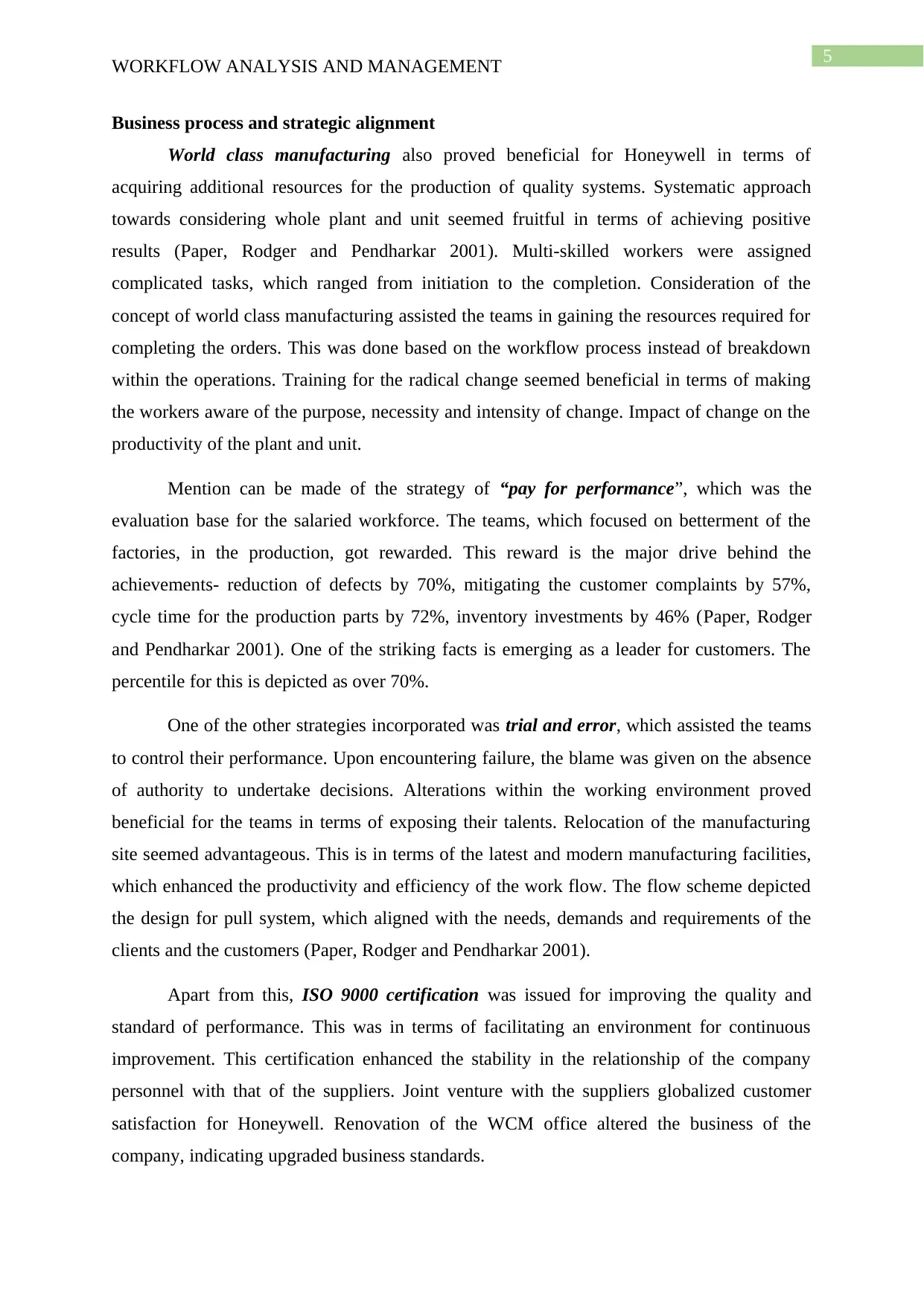
5
WORKFLOW ANALYSIS AND MANAGEMENT
Business process and strategic alignment
World class manufacturing also proved beneficial for Honeywell in terms of
acquiring additional resources for the production of quality systems. Systematic approach
towards considering whole plant and unit seemed fruitful in terms of achieving positive
results (Paper, Rodger and Pendharkar 2001). Multi-skilled workers were assigned
complicated tasks, which ranged from initiation to the completion. Consideration of the
concept of world class manufacturing assisted the teams in gaining the resources required for
completing the orders. This was done based on the workflow process instead of breakdown
within the operations. Training for the radical change seemed beneficial in terms of making
the workers aware of the purpose, necessity and intensity of change. Impact of change on the
productivity of the plant and unit.
Mention can be made of the strategy of “pay for performance”, which was the
evaluation base for the salaried workforce. The teams, which focused on betterment of the
factories, in the production, got rewarded. This reward is the major drive behind the
achievements- reduction of defects by 70%, mitigating the customer complaints by 57%,
cycle time for the production parts by 72%, inventory investments by 46% (Paper, Rodger
and Pendharkar 2001). One of the striking facts is emerging as a leader for customers. The
percentile for this is depicted as over 70%.
One of the other strategies incorporated was trial and error, which assisted the teams
to control their performance. Upon encountering failure, the blame was given on the absence
of authority to undertake decisions. Alterations within the working environment proved
beneficial for the teams in terms of exposing their talents. Relocation of the manufacturing
site seemed advantageous. This is in terms of the latest and modern manufacturing facilities,
which enhanced the productivity and efficiency of the work flow. The flow scheme depicted
the design for pull system, which aligned with the needs, demands and requirements of the
clients and the customers (Paper, Rodger and Pendharkar 2001).
Apart from this, ISO 9000 certification was issued for improving the quality and
standard of performance. This was in terms of facilitating an environment for continuous
improvement. This certification enhanced the stability in the relationship of the company
personnel with that of the suppliers. Joint venture with the suppliers globalized customer
satisfaction for Honeywell. Renovation of the WCM office altered the business of the
company, indicating upgraded business standards.
WORKFLOW ANALYSIS AND MANAGEMENT
Business process and strategic alignment
World class manufacturing also proved beneficial for Honeywell in terms of
acquiring additional resources for the production of quality systems. Systematic approach
towards considering whole plant and unit seemed fruitful in terms of achieving positive
results (Paper, Rodger and Pendharkar 2001). Multi-skilled workers were assigned
complicated tasks, which ranged from initiation to the completion. Consideration of the
concept of world class manufacturing assisted the teams in gaining the resources required for
completing the orders. This was done based on the workflow process instead of breakdown
within the operations. Training for the radical change seemed beneficial in terms of making
the workers aware of the purpose, necessity and intensity of change. Impact of change on the
productivity of the plant and unit.
Mention can be made of the strategy of “pay for performance”, which was the
evaluation base for the salaried workforce. The teams, which focused on betterment of the
factories, in the production, got rewarded. This reward is the major drive behind the
achievements- reduction of defects by 70%, mitigating the customer complaints by 57%,
cycle time for the production parts by 72%, inventory investments by 46% (Paper, Rodger
and Pendharkar 2001). One of the striking facts is emerging as a leader for customers. The
percentile for this is depicted as over 70%.
One of the other strategies incorporated was trial and error, which assisted the teams
to control their performance. Upon encountering failure, the blame was given on the absence
of authority to undertake decisions. Alterations within the working environment proved
beneficial for the teams in terms of exposing their talents. Relocation of the manufacturing
site seemed advantageous. This is in terms of the latest and modern manufacturing facilities,
which enhanced the productivity and efficiency of the work flow. The flow scheme depicted
the design for pull system, which aligned with the needs, demands and requirements of the
clients and the customers (Paper, Rodger and Pendharkar 2001).
Apart from this, ISO 9000 certification was issued for improving the quality and
standard of performance. This was in terms of facilitating an environment for continuous
improvement. This certification enhanced the stability in the relationship of the company
personnel with that of the suppliers. Joint venture with the suppliers globalized customer
satisfaction for Honeywell. Renovation of the WCM office altered the business of the
company, indicating upgraded business standards.
⊘ This is a preview!⊘
Do you want full access?
Subscribe today to unlock all pages.

Trusted by 1+ million students worldwide
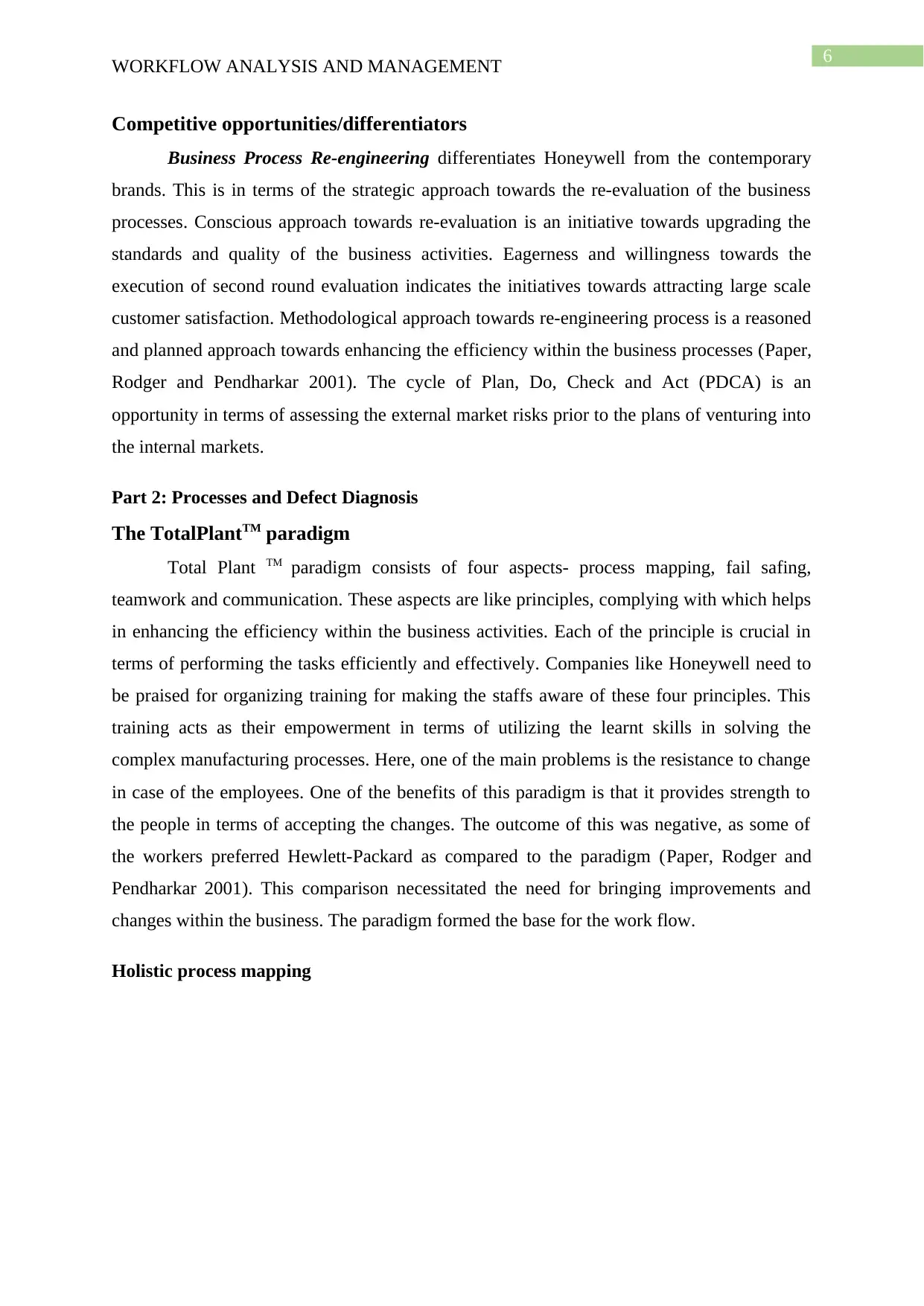
6
WORKFLOW ANALYSIS AND MANAGEMENT
Competitive opportunities/differentiators
Business Process Re-engineering differentiates Honeywell from the contemporary
brands. This is in terms of the strategic approach towards the re-evaluation of the business
processes. Conscious approach towards re-evaluation is an initiative towards upgrading the
standards and quality of the business activities. Eagerness and willingness towards the
execution of second round evaluation indicates the initiatives towards attracting large scale
customer satisfaction. Methodological approach towards re-engineering process is a reasoned
and planned approach towards enhancing the efficiency within the business processes (Paper,
Rodger and Pendharkar 2001). The cycle of Plan, Do, Check and Act (PDCA) is an
opportunity in terms of assessing the external market risks prior to the plans of venturing into
the internal markets.
Part 2: Processes and Defect Diagnosis
The TotalPlantTM paradigm
Total Plant TM paradigm consists of four aspects- process mapping, fail safing,
teamwork and communication. These aspects are like principles, complying with which helps
in enhancing the efficiency within the business activities. Each of the principle is crucial in
terms of performing the tasks efficiently and effectively. Companies like Honeywell need to
be praised for organizing training for making the staffs aware of these four principles. This
training acts as their empowerment in terms of utilizing the learnt skills in solving the
complex manufacturing processes. Here, one of the main problems is the resistance to change
in case of the employees. One of the benefits of this paradigm is that it provides strength to
the people in terms of accepting the changes. The outcome of this was negative, as some of
the workers preferred Hewlett-Packard as compared to the paradigm (Paper, Rodger and
Pendharkar 2001). This comparison necessitated the need for bringing improvements and
changes within the business. The paradigm formed the base for the work flow.
Holistic process mapping
WORKFLOW ANALYSIS AND MANAGEMENT
Competitive opportunities/differentiators
Business Process Re-engineering differentiates Honeywell from the contemporary
brands. This is in terms of the strategic approach towards the re-evaluation of the business
processes. Conscious approach towards re-evaluation is an initiative towards upgrading the
standards and quality of the business activities. Eagerness and willingness towards the
execution of second round evaluation indicates the initiatives towards attracting large scale
customer satisfaction. Methodological approach towards re-engineering process is a reasoned
and planned approach towards enhancing the efficiency within the business processes (Paper,
Rodger and Pendharkar 2001). The cycle of Plan, Do, Check and Act (PDCA) is an
opportunity in terms of assessing the external market risks prior to the plans of venturing into
the internal markets.
Part 2: Processes and Defect Diagnosis
The TotalPlantTM paradigm
Total Plant TM paradigm consists of four aspects- process mapping, fail safing,
teamwork and communication. These aspects are like principles, complying with which helps
in enhancing the efficiency within the business activities. Each of the principle is crucial in
terms of performing the tasks efficiently and effectively. Companies like Honeywell need to
be praised for organizing training for making the staffs aware of these four principles. This
training acts as their empowerment in terms of utilizing the learnt skills in solving the
complex manufacturing processes. Here, one of the main problems is the resistance to change
in case of the employees. One of the benefits of this paradigm is that it provides strength to
the people in terms of accepting the changes. The outcome of this was negative, as some of
the workers preferred Hewlett-Packard as compared to the paradigm (Paper, Rodger and
Pendharkar 2001). This comparison necessitated the need for bringing improvements and
changes within the business. The paradigm formed the base for the work flow.
Holistic process mapping
Paraphrase This Document
Need a fresh take? Get an instant paraphrase of this document with our AI Paraphraser
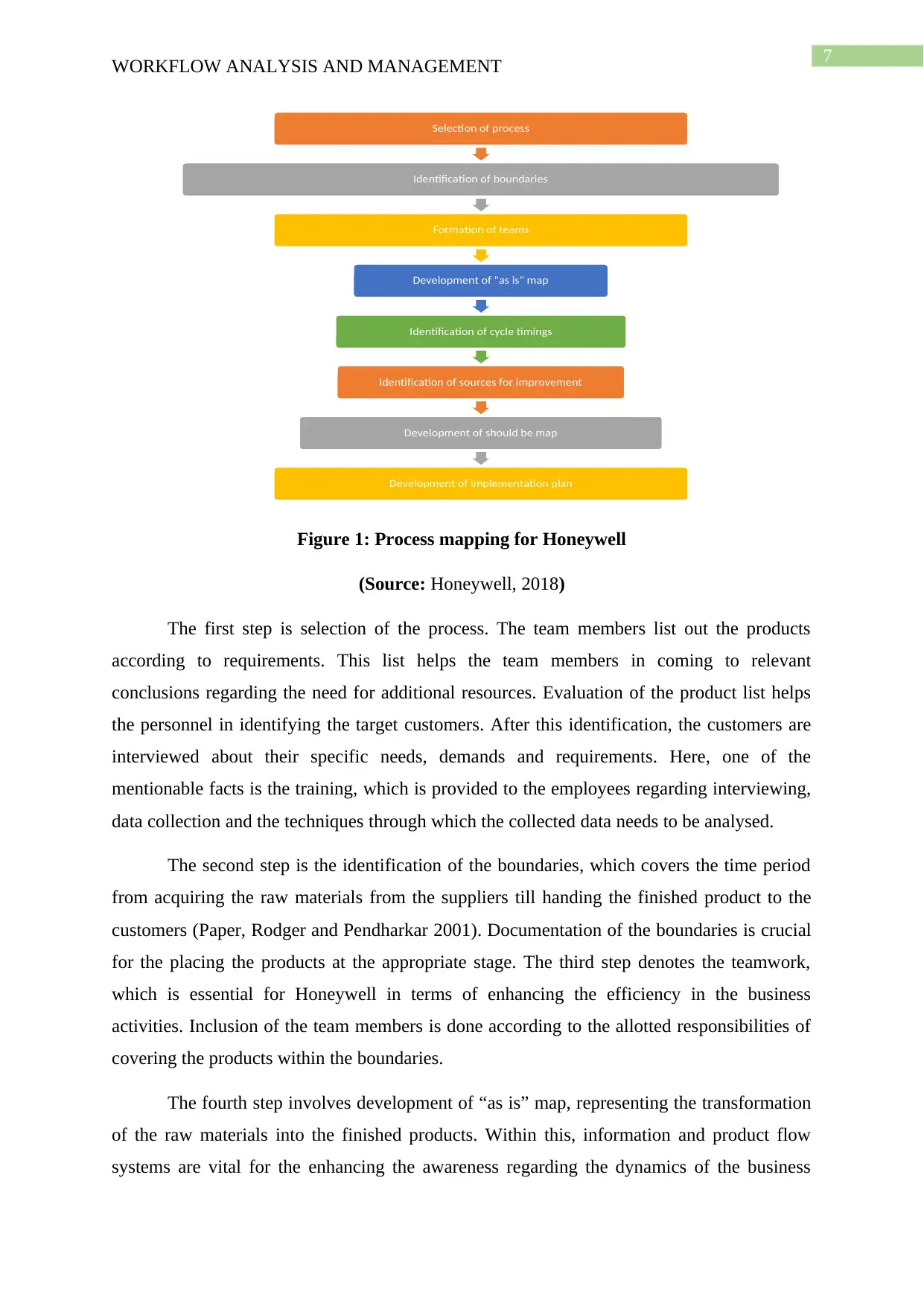
7
WORKFLOW ANALYSIS AND MANAGEMENT
Figure 1: Process mapping for Honeywell
(Source: Honeywell, 2018)
The first step is selection of the process. The team members list out the products
according to requirements. This list helps the team members in coming to relevant
conclusions regarding the need for additional resources. Evaluation of the product list helps
the personnel in identifying the target customers. After this identification, the customers are
interviewed about their specific needs, demands and requirements. Here, one of the
mentionable facts is the training, which is provided to the employees regarding interviewing,
data collection and the techniques through which the collected data needs to be analysed.
The second step is the identification of the boundaries, which covers the time period
from acquiring the raw materials from the suppliers till handing the finished product to the
customers (Paper, Rodger and Pendharkar 2001). Documentation of the boundaries is crucial
for the placing the products at the appropriate stage. The third step denotes the teamwork,
which is essential for Honeywell in terms of enhancing the efficiency in the business
activities. Inclusion of the team members is done according to the allotted responsibilities of
covering the products within the boundaries.
The fourth step involves development of “as is” map, representing the transformation
of the raw materials into the finished products. Within this, information and product flow
systems are vital for the enhancing the awareness regarding the dynamics of the business
Selection of process
Identification of boundaries
Formation of teams
Development of "as is" map
Identification of cycle timings
Identification of sources for improvement
Development of should be map
Development of implementation plan
WORKFLOW ANALYSIS AND MANAGEMENT
Figure 1: Process mapping for Honeywell
(Source: Honeywell, 2018)
The first step is selection of the process. The team members list out the products
according to requirements. This list helps the team members in coming to relevant
conclusions regarding the need for additional resources. Evaluation of the product list helps
the personnel in identifying the target customers. After this identification, the customers are
interviewed about their specific needs, demands and requirements. Here, one of the
mentionable facts is the training, which is provided to the employees regarding interviewing,
data collection and the techniques through which the collected data needs to be analysed.
The second step is the identification of the boundaries, which covers the time period
from acquiring the raw materials from the suppliers till handing the finished product to the
customers (Paper, Rodger and Pendharkar 2001). Documentation of the boundaries is crucial
for the placing the products at the appropriate stage. The third step denotes the teamwork,
which is essential for Honeywell in terms of enhancing the efficiency in the business
activities. Inclusion of the team members is done according to the allotted responsibilities of
covering the products within the boundaries.
The fourth step involves development of “as is” map, representing the transformation
of the raw materials into the finished products. Within this, information and product flow
systems are vital for the enhancing the awareness regarding the dynamics of the business
Selection of process
Identification of boundaries
Formation of teams
Development of "as is" map
Identification of cycle timings
Identification of sources for improvement
Development of should be map
Development of implementation plan
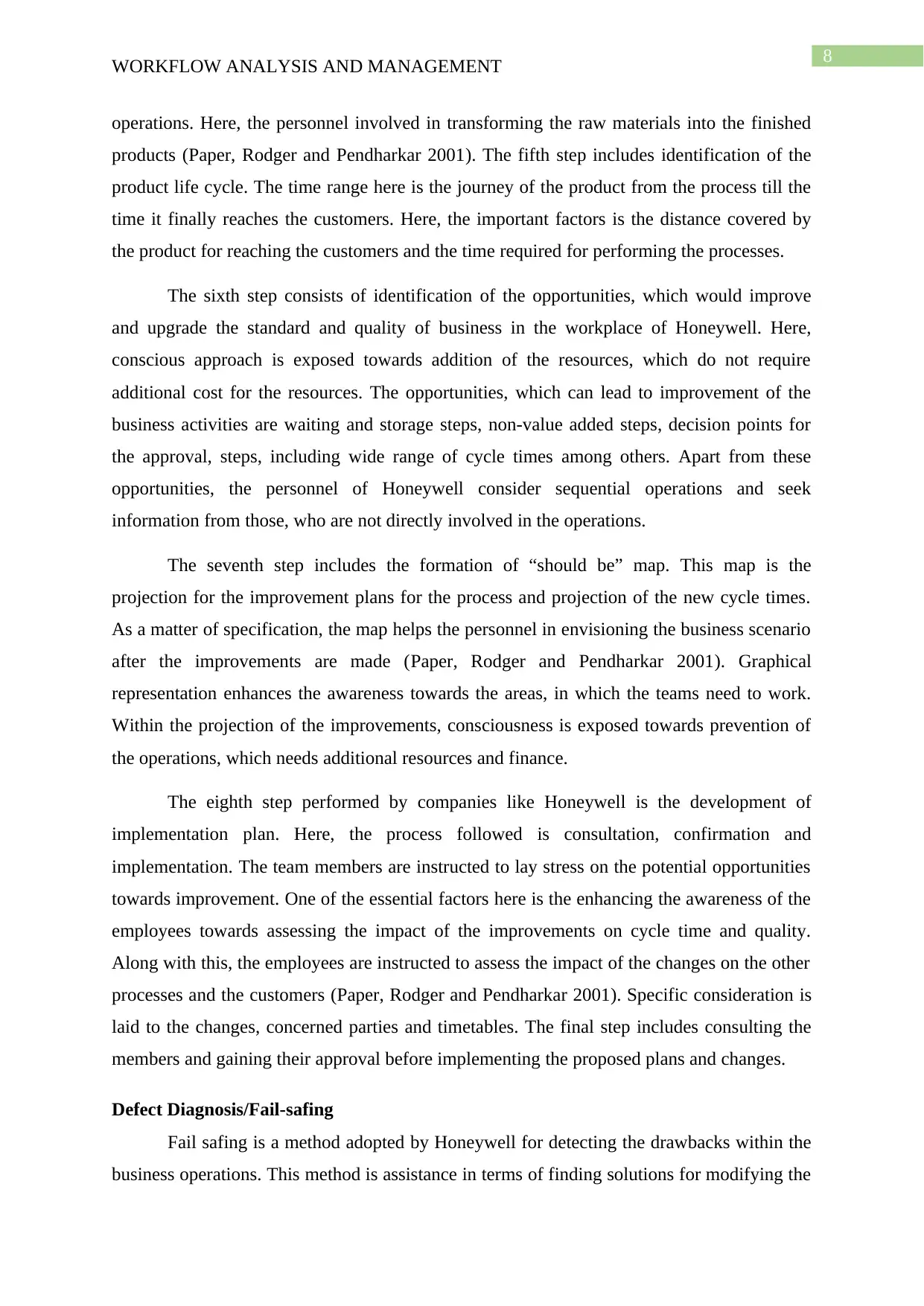
8
WORKFLOW ANALYSIS AND MANAGEMENT
operations. Here, the personnel involved in transforming the raw materials into the finished
products (Paper, Rodger and Pendharkar 2001). The fifth step includes identification of the
product life cycle. The time range here is the journey of the product from the process till the
time it finally reaches the customers. Here, the important factors is the distance covered by
the product for reaching the customers and the time required for performing the processes.
The sixth step consists of identification of the opportunities, which would improve
and upgrade the standard and quality of business in the workplace of Honeywell. Here,
conscious approach is exposed towards addition of the resources, which do not require
additional cost for the resources. The opportunities, which can lead to improvement of the
business activities are waiting and storage steps, non-value added steps, decision points for
the approval, steps, including wide range of cycle times among others. Apart from these
opportunities, the personnel of Honeywell consider sequential operations and seek
information from those, who are not directly involved in the operations.
The seventh step includes the formation of “should be” map. This map is the
projection for the improvement plans for the process and projection of the new cycle times.
As a matter of specification, the map helps the personnel in envisioning the business scenario
after the improvements are made (Paper, Rodger and Pendharkar 2001). Graphical
representation enhances the awareness towards the areas, in which the teams need to work.
Within the projection of the improvements, consciousness is exposed towards prevention of
the operations, which needs additional resources and finance.
The eighth step performed by companies like Honeywell is the development of
implementation plan. Here, the process followed is consultation, confirmation and
implementation. The team members are instructed to lay stress on the potential opportunities
towards improvement. One of the essential factors here is the enhancing the awareness of the
employees towards assessing the impact of the improvements on cycle time and quality.
Along with this, the employees are instructed to assess the impact of the changes on the other
processes and the customers (Paper, Rodger and Pendharkar 2001). Specific consideration is
laid to the changes, concerned parties and timetables. The final step includes consulting the
members and gaining their approval before implementing the proposed plans and changes.
Defect Diagnosis/Fail-safing
Fail safing is a method adopted by Honeywell for detecting the drawbacks within the
business operations. This method is assistance in terms of finding solutions for modifying the
WORKFLOW ANALYSIS AND MANAGEMENT
operations. Here, the personnel involved in transforming the raw materials into the finished
products (Paper, Rodger and Pendharkar 2001). The fifth step includes identification of the
product life cycle. The time range here is the journey of the product from the process till the
time it finally reaches the customers. Here, the important factors is the distance covered by
the product for reaching the customers and the time required for performing the processes.
The sixth step consists of identification of the opportunities, which would improve
and upgrade the standard and quality of business in the workplace of Honeywell. Here,
conscious approach is exposed towards addition of the resources, which do not require
additional cost for the resources. The opportunities, which can lead to improvement of the
business activities are waiting and storage steps, non-value added steps, decision points for
the approval, steps, including wide range of cycle times among others. Apart from these
opportunities, the personnel of Honeywell consider sequential operations and seek
information from those, who are not directly involved in the operations.
The seventh step includes the formation of “should be” map. This map is the
projection for the improvement plans for the process and projection of the new cycle times.
As a matter of specification, the map helps the personnel in envisioning the business scenario
after the improvements are made (Paper, Rodger and Pendharkar 2001). Graphical
representation enhances the awareness towards the areas, in which the teams need to work.
Within the projection of the improvements, consciousness is exposed towards prevention of
the operations, which needs additional resources and finance.
The eighth step performed by companies like Honeywell is the development of
implementation plan. Here, the process followed is consultation, confirmation and
implementation. The team members are instructed to lay stress on the potential opportunities
towards improvement. One of the essential factors here is the enhancing the awareness of the
employees towards assessing the impact of the improvements on cycle time and quality.
Along with this, the employees are instructed to assess the impact of the changes on the other
processes and the customers (Paper, Rodger and Pendharkar 2001). Specific consideration is
laid to the changes, concerned parties and timetables. The final step includes consulting the
members and gaining their approval before implementing the proposed plans and changes.
Defect Diagnosis/Fail-safing
Fail safing is a method adopted by Honeywell for detecting the drawbacks within the
business operations. This method is assistance in terms of finding solutions for modifying the
⊘ This is a preview!⊘
Do you want full access?
Subscribe today to unlock all pages.

Trusted by 1+ million students worldwide
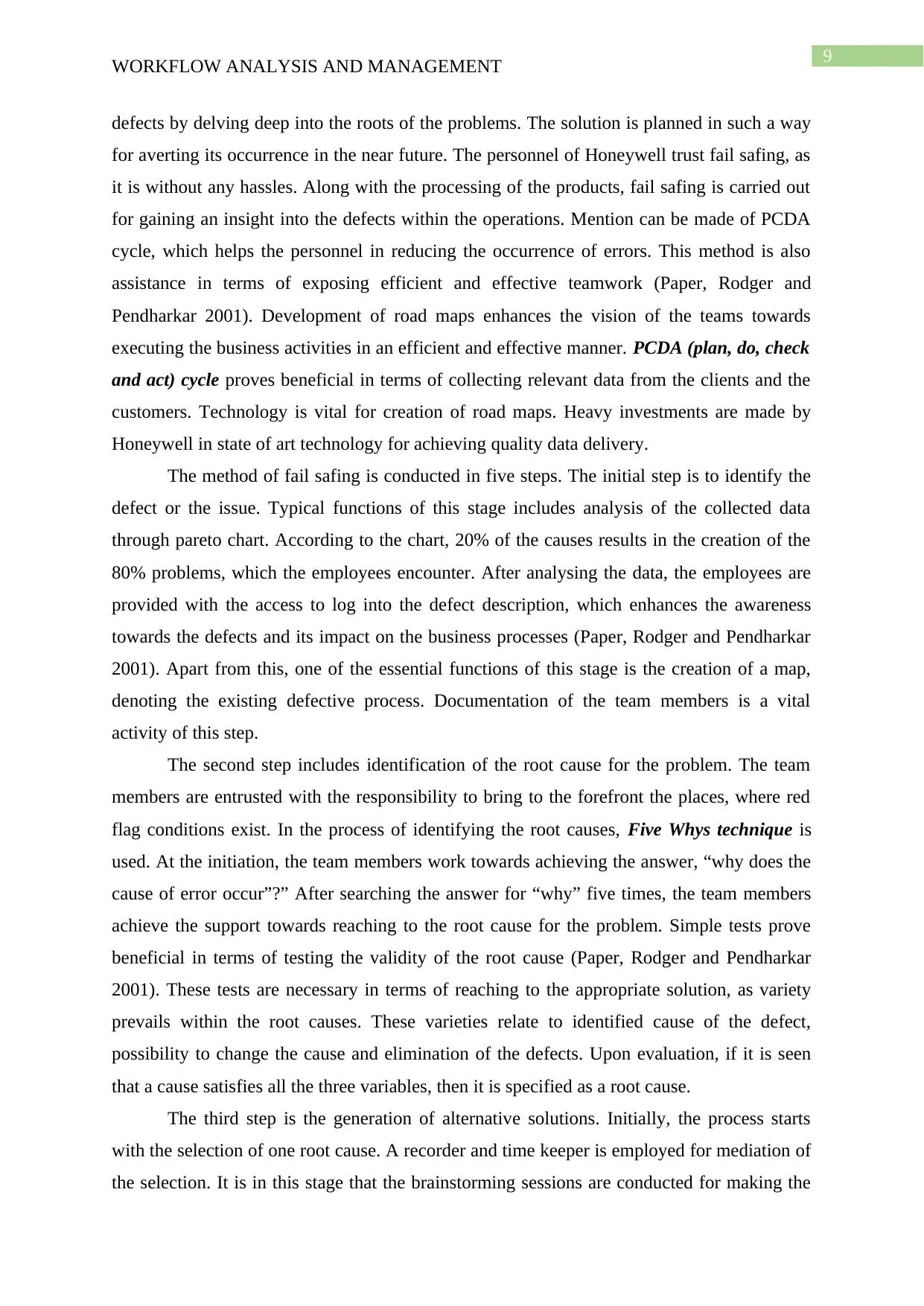
9
WORKFLOW ANALYSIS AND MANAGEMENT
defects by delving deep into the roots of the problems. The solution is planned in such a way
for averting its occurrence in the near future. The personnel of Honeywell trust fail safing, as
it is without any hassles. Along with the processing of the products, fail safing is carried out
for gaining an insight into the defects within the operations. Mention can be made of PCDA
cycle, which helps the personnel in reducing the occurrence of errors. This method is also
assistance in terms of exposing efficient and effective teamwork (Paper, Rodger and
Pendharkar 2001). Development of road maps enhances the vision of the teams towards
executing the business activities in an efficient and effective manner. PCDA (plan, do, check
and act) cycle proves beneficial in terms of collecting relevant data from the clients and the
customers. Technology is vital for creation of road maps. Heavy investments are made by
Honeywell in state of art technology for achieving quality data delivery.
The method of fail safing is conducted in five steps. The initial step is to identify the
defect or the issue. Typical functions of this stage includes analysis of the collected data
through pareto chart. According to the chart, 20% of the causes results in the creation of the
80% problems, which the employees encounter. After analysing the data, the employees are
provided with the access to log into the defect description, which enhances the awareness
towards the defects and its impact on the business processes (Paper, Rodger and Pendharkar
2001). Apart from this, one of the essential functions of this stage is the creation of a map,
denoting the existing defective process. Documentation of the team members is a vital
activity of this step.
The second step includes identification of the root cause for the problem. The team
members are entrusted with the responsibility to bring to the forefront the places, where red
flag conditions exist. In the process of identifying the root causes, Five Whys technique is
used. At the initiation, the team members work towards achieving the answer, “why does the
cause of error occur”?” After searching the answer for “why” five times, the team members
achieve the support towards reaching to the root cause for the problem. Simple tests prove
beneficial in terms of testing the validity of the root cause (Paper, Rodger and Pendharkar
2001). These tests are necessary in terms of reaching to the appropriate solution, as variety
prevails within the root causes. These varieties relate to identified cause of the defect,
possibility to change the cause and elimination of the defects. Upon evaluation, if it is seen
that a cause satisfies all the three variables, then it is specified as a root cause.
The third step is the generation of alternative solutions. Initially, the process starts
with the selection of one root cause. A recorder and time keeper is employed for mediation of
the selection. It is in this stage that the brainstorming sessions are conducted for making the
WORKFLOW ANALYSIS AND MANAGEMENT
defects by delving deep into the roots of the problems. The solution is planned in such a way
for averting its occurrence in the near future. The personnel of Honeywell trust fail safing, as
it is without any hassles. Along with the processing of the products, fail safing is carried out
for gaining an insight into the defects within the operations. Mention can be made of PCDA
cycle, which helps the personnel in reducing the occurrence of errors. This method is also
assistance in terms of exposing efficient and effective teamwork (Paper, Rodger and
Pendharkar 2001). Development of road maps enhances the vision of the teams towards
executing the business activities in an efficient and effective manner. PCDA (plan, do, check
and act) cycle proves beneficial in terms of collecting relevant data from the clients and the
customers. Technology is vital for creation of road maps. Heavy investments are made by
Honeywell in state of art technology for achieving quality data delivery.
The method of fail safing is conducted in five steps. The initial step is to identify the
defect or the issue. Typical functions of this stage includes analysis of the collected data
through pareto chart. According to the chart, 20% of the causes results in the creation of the
80% problems, which the employees encounter. After analysing the data, the employees are
provided with the access to log into the defect description, which enhances the awareness
towards the defects and its impact on the business processes (Paper, Rodger and Pendharkar
2001). Apart from this, one of the essential functions of this stage is the creation of a map,
denoting the existing defective process. Documentation of the team members is a vital
activity of this step.
The second step includes identification of the root cause for the problem. The team
members are entrusted with the responsibility to bring to the forefront the places, where red
flag conditions exist. In the process of identifying the root causes, Five Whys technique is
used. At the initiation, the team members work towards achieving the answer, “why does the
cause of error occur”?” After searching the answer for “why” five times, the team members
achieve the support towards reaching to the root cause for the problem. Simple tests prove
beneficial in terms of testing the validity of the root cause (Paper, Rodger and Pendharkar
2001). These tests are necessary in terms of reaching to the appropriate solution, as variety
prevails within the root causes. These varieties relate to identified cause of the defect,
possibility to change the cause and elimination of the defects. Upon evaluation, if it is seen
that a cause satisfies all the three variables, then it is specified as a root cause.
The third step is the generation of alternative solutions. Initially, the process starts
with the selection of one root cause. A recorder and time keeper is employed for mediation of
the selection. It is in this stage that the brainstorming sessions are conducted for making the
Paraphrase This Document
Need a fresh take? Get an instant paraphrase of this document with our AI Paraphraser
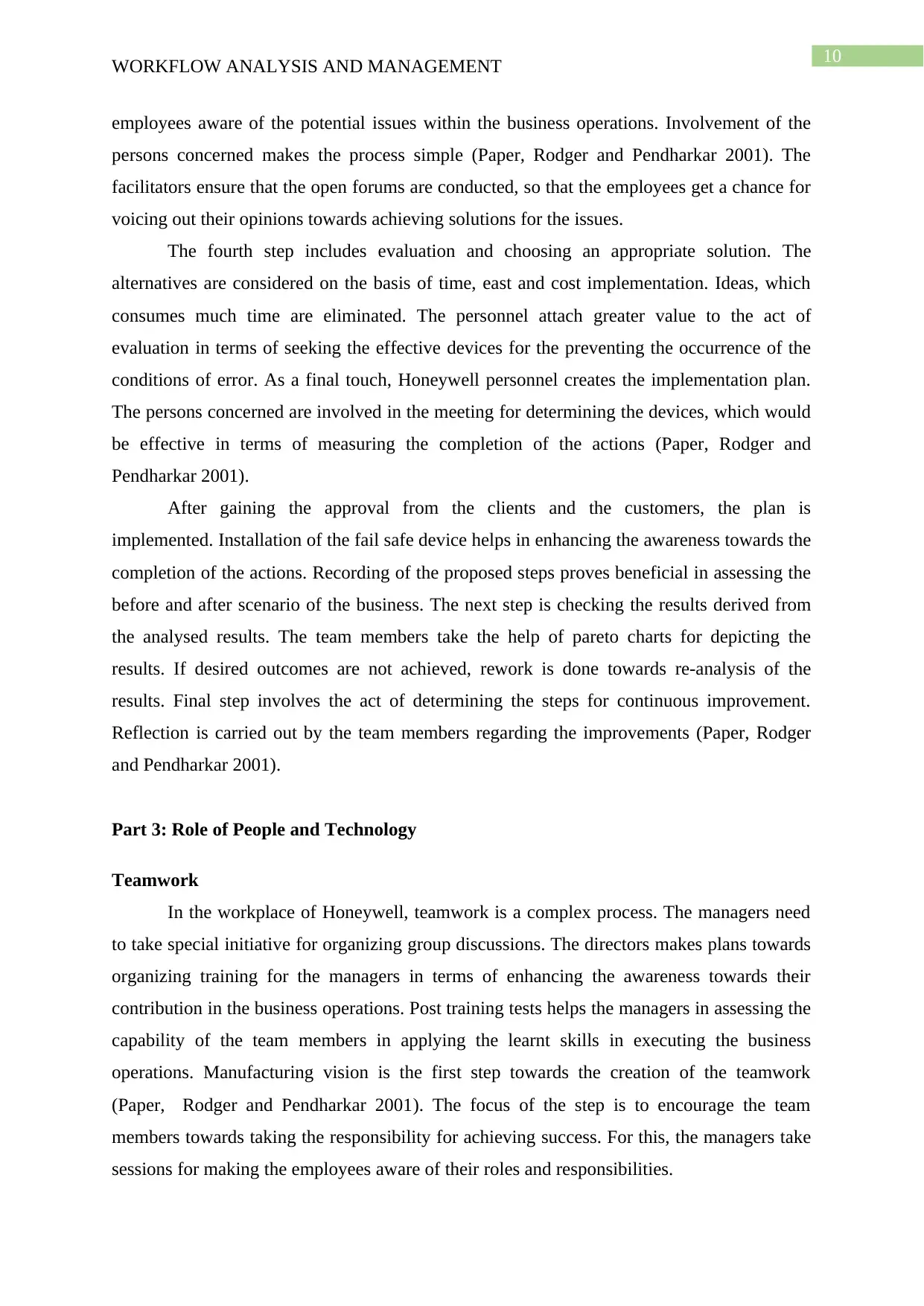
10
WORKFLOW ANALYSIS AND MANAGEMENT
employees aware of the potential issues within the business operations. Involvement of the
persons concerned makes the process simple (Paper, Rodger and Pendharkar 2001). The
facilitators ensure that the open forums are conducted, so that the employees get a chance for
voicing out their opinions towards achieving solutions for the issues.
The fourth step includes evaluation and choosing an appropriate solution. The
alternatives are considered on the basis of time, east and cost implementation. Ideas, which
consumes much time are eliminated. The personnel attach greater value to the act of
evaluation in terms of seeking the effective devices for the preventing the occurrence of the
conditions of error. As a final touch, Honeywell personnel creates the implementation plan.
The persons concerned are involved in the meeting for determining the devices, which would
be effective in terms of measuring the completion of the actions (Paper, Rodger and
Pendharkar 2001).
After gaining the approval from the clients and the customers, the plan is
implemented. Installation of the fail safe device helps in enhancing the awareness towards the
completion of the actions. Recording of the proposed steps proves beneficial in assessing the
before and after scenario of the business. The next step is checking the results derived from
the analysed results. The team members take the help of pareto charts for depicting the
results. If desired outcomes are not achieved, rework is done towards re-analysis of the
results. Final step involves the act of determining the steps for continuous improvement.
Reflection is carried out by the team members regarding the improvements (Paper, Rodger
and Pendharkar 2001).
Part 3: Role of People and Technology
Teamwork
In the workplace of Honeywell, teamwork is a complex process. The managers need
to take special initiative for organizing group discussions. The directors makes plans towards
organizing training for the managers in terms of enhancing the awareness towards their
contribution in the business operations. Post training tests helps the managers in assessing the
capability of the team members in applying the learnt skills in executing the business
operations. Manufacturing vision is the first step towards the creation of the teamwork
(Paper, Rodger and Pendharkar 2001). The focus of the step is to encourage the team
members towards taking the responsibility for achieving success. For this, the managers take
sessions for making the employees aware of their roles and responsibilities.
WORKFLOW ANALYSIS AND MANAGEMENT
employees aware of the potential issues within the business operations. Involvement of the
persons concerned makes the process simple (Paper, Rodger and Pendharkar 2001). The
facilitators ensure that the open forums are conducted, so that the employees get a chance for
voicing out their opinions towards achieving solutions for the issues.
The fourth step includes evaluation and choosing an appropriate solution. The
alternatives are considered on the basis of time, east and cost implementation. Ideas, which
consumes much time are eliminated. The personnel attach greater value to the act of
evaluation in terms of seeking the effective devices for the preventing the occurrence of the
conditions of error. As a final touch, Honeywell personnel creates the implementation plan.
The persons concerned are involved in the meeting for determining the devices, which would
be effective in terms of measuring the completion of the actions (Paper, Rodger and
Pendharkar 2001).
After gaining the approval from the clients and the customers, the plan is
implemented. Installation of the fail safe device helps in enhancing the awareness towards the
completion of the actions. Recording of the proposed steps proves beneficial in assessing the
before and after scenario of the business. The next step is checking the results derived from
the analysed results. The team members take the help of pareto charts for depicting the
results. If desired outcomes are not achieved, rework is done towards re-analysis of the
results. Final step involves the act of determining the steps for continuous improvement.
Reflection is carried out by the team members regarding the improvements (Paper, Rodger
and Pendharkar 2001).
Part 3: Role of People and Technology
Teamwork
In the workplace of Honeywell, teamwork is a complex process. The managers need
to take special initiative for organizing group discussions. The directors makes plans towards
organizing training for the managers in terms of enhancing the awareness towards their
contribution in the business operations. Post training tests helps the managers in assessing the
capability of the team members in applying the learnt skills in executing the business
operations. Manufacturing vision is the first step towards the creation of the teamwork
(Paper, Rodger and Pendharkar 2001). The focus of the step is to encourage the team
members towards taking the responsibility for achieving success. For this, the managers take
sessions for making the employees aware of their roles and responsibilities.
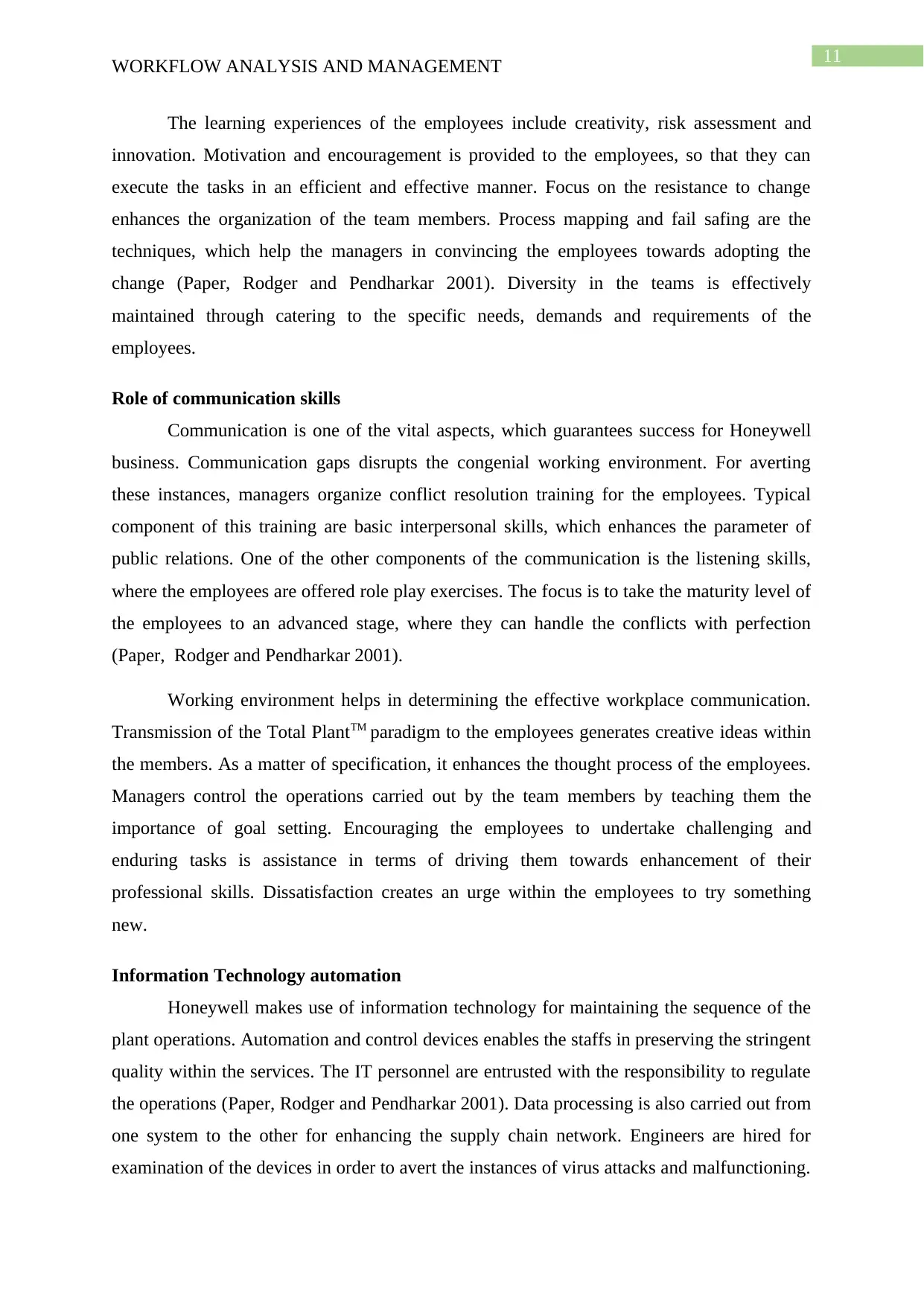
11
WORKFLOW ANALYSIS AND MANAGEMENT
The learning experiences of the employees include creativity, risk assessment and
innovation. Motivation and encouragement is provided to the employees, so that they can
execute the tasks in an efficient and effective manner. Focus on the resistance to change
enhances the organization of the team members. Process mapping and fail safing are the
techniques, which help the managers in convincing the employees towards adopting the
change (Paper, Rodger and Pendharkar 2001). Diversity in the teams is effectively
maintained through catering to the specific needs, demands and requirements of the
employees.
Role of communication skills
Communication is one of the vital aspects, which guarantees success for Honeywell
business. Communication gaps disrupts the congenial working environment. For averting
these instances, managers organize conflict resolution training for the employees. Typical
component of this training are basic interpersonal skills, which enhances the parameter of
public relations. One of the other components of the communication is the listening skills,
where the employees are offered role play exercises. The focus is to take the maturity level of
the employees to an advanced stage, where they can handle the conflicts with perfection
(Paper, Rodger and Pendharkar 2001).
Working environment helps in determining the effective workplace communication.
Transmission of the Total PlantTM paradigm to the employees generates creative ideas within
the members. As a matter of specification, it enhances the thought process of the employees.
Managers control the operations carried out by the team members by teaching them the
importance of goal setting. Encouraging the employees to undertake challenging and
enduring tasks is assistance in terms of driving them towards enhancement of their
professional skills. Dissatisfaction creates an urge within the employees to try something
new.
Information Technology automation
Honeywell makes use of information technology for maintaining the sequence of the
plant operations. Automation and control devices enables the staffs in preserving the stringent
quality within the services. The IT personnel are entrusted with the responsibility to regulate
the operations (Paper, Rodger and Pendharkar 2001). Data processing is also carried out from
one system to the other for enhancing the supply chain network. Engineers are hired for
examination of the devices in order to avert the instances of virus attacks and malfunctioning.
WORKFLOW ANALYSIS AND MANAGEMENT
The learning experiences of the employees include creativity, risk assessment and
innovation. Motivation and encouragement is provided to the employees, so that they can
execute the tasks in an efficient and effective manner. Focus on the resistance to change
enhances the organization of the team members. Process mapping and fail safing are the
techniques, which help the managers in convincing the employees towards adopting the
change (Paper, Rodger and Pendharkar 2001). Diversity in the teams is effectively
maintained through catering to the specific needs, demands and requirements of the
employees.
Role of communication skills
Communication is one of the vital aspects, which guarantees success for Honeywell
business. Communication gaps disrupts the congenial working environment. For averting
these instances, managers organize conflict resolution training for the employees. Typical
component of this training are basic interpersonal skills, which enhances the parameter of
public relations. One of the other components of the communication is the listening skills,
where the employees are offered role play exercises. The focus is to take the maturity level of
the employees to an advanced stage, where they can handle the conflicts with perfection
(Paper, Rodger and Pendharkar 2001).
Working environment helps in determining the effective workplace communication.
Transmission of the Total PlantTM paradigm to the employees generates creative ideas within
the members. As a matter of specification, it enhances the thought process of the employees.
Managers control the operations carried out by the team members by teaching them the
importance of goal setting. Encouraging the employees to undertake challenging and
enduring tasks is assistance in terms of driving them towards enhancement of their
professional skills. Dissatisfaction creates an urge within the employees to try something
new.
Information Technology automation
Honeywell makes use of information technology for maintaining the sequence of the
plant operations. Automation and control devices enables the staffs in preserving the stringent
quality within the services. The IT personnel are entrusted with the responsibility to regulate
the operations (Paper, Rodger and Pendharkar 2001). Data processing is also carried out from
one system to the other for enhancing the supply chain network. Engineers are hired for
examination of the devices in order to avert the instances of virus attacks and malfunctioning.
⊘ This is a preview!⊘
Do you want full access?
Subscribe today to unlock all pages.

Trusted by 1+ million students worldwide
1 out of 18
Related Documents
Your All-in-One AI-Powered Toolkit for Academic Success.
+13062052269
info@desklib.com
Available 24*7 on WhatsApp / Email
![[object Object]](/_next/static/media/star-bottom.7253800d.svg)
Unlock your academic potential
Copyright © 2020–2025 A2Z Services. All Rights Reserved. Developed and managed by ZUCOL.





